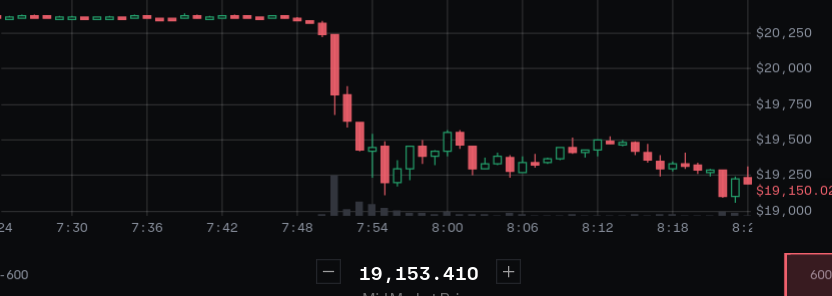 I was woken at eight this morning (BST) by my Signal pinging repeatedly. Bitcoin had finally broken $20,000 — dropping $1,200 in five minutes. I declare this bubble conclusively popped.
I was woken at eight this morning (BST) by my Signal pinging repeatedly. Bitcoin had finally broken $20,000 — dropping $1,200 in five minutes. I declare this bubble conclusively popped.
Crypto’s been running on fumes since about June 2021 — just after Elon Musk left Bitcoin, and the retail dollars followed him.
The last remaining retail buyers got burnt by the Terra-Luna collapse a month ago. Horrifying numbers of ordinary naïve investors got into Luna, with no idea what they were getting into — and they were absolutely destroyed.
I suspect this is why the Coinbase crypto exchange declared a sudden hiring freeze in May 2022, and laid off 18% of staff this week. [WSJ, paywalled] As the biggest exchange for ordinary retail customers, they know precisely what the retail market is doing. They saw the influx of actual dollars go down, and got scared.
Crypto has been consuming itself in acid ketosis since May — because the actual dollars have gone.
Celebrations in Australia! [citation needed]
Ponziception
As Amy and I noted on Tuesday, the entire crypto space has been a Jenga stack of interconnected time bombs for months now, as the companies find new ways to prop each other up.
Headlines talked about millions, billions, trillions of dollars in crypto being made or lost — but that’s all virtual money that never existed.
With a serious shortage of actual dollars, the crypto economy had to keep coming up with more and more elaborate schemes to try to extract real money from retail investors. Venture capitalists frantically promoted NFTs and Web3, trying to lure in precious dollars.
The 2021 bubble brought forth a wave of “investment firms” offering interest rates on the order of 20%. This is just not possible in the present economy. If anyone offers 20%, your first thought should be: “what’s wrong here?”
(I can see why people didn’t question it. I’m 55, and I remember 18% interest rates in the 1980s. Part of me still feels like that’s a reasonable and achievable number — even as I know in my head it absolutely isn’t.)
These crypto shadow banks made their money from very risky investments in crypto for high yield. They rapidly turned into Ponzi schemes, paying early investors with money from later investors. There’s no other way to pay 20% interest. Where possible, they paid customers’ yield in their own made-up token — Celsius paid higher interest if you accepted CEL tokens, for instance.
These Ponzis then doubled down and invested in their fellow Ponzis. Did they not realise that the other guy with an identical business model was doing what they were?
I guess they didn’t — back in the ICO era, a lot of ICOs would invest in other ICOs. And I’ll always remember the funds that offered insurance against Pirateat40’s 2012 Bitcoin Savings and Trust collapsing … and put the insurance premiums into the Pirateat40 Ponzi. (Attack, chapter 4.)
It’s important to note that literally everyone involved was fully equipped to have known better. Terra/Luna was obviously going to fail. It was supported by nothing — UST backed Luna and Luna backed UST. People had been saying for months that it could collapse at any moment.
These sophisticated investments firms with “billions” of dollars in cryptos went all-in on this completely made-up asset — just as if it had any reason not to collapse.
These guys are just not very bright. But in a bubble, everyone looks like a genius.
Then, on Monday, Celsius collapsed. Celsius had been up to their necks in UST and Luna, and made many other blitheringly stupid trades out of desperation, shouting “YOLO!” as they repeatedly dived head first into risky nonsense — BadgerDAO, Terra/Luna, stEth. [Twitter; FT, paywalled]
Everyone was in everyone else’s pockets. So when one collapsed, everyone else followed. After Celsius on Monday and Three Arrows Capital (3AC) on Wednesday, we had Finblox on Thursday and Babel on Friday.
3AC was up to its neck in GBTC, which had pumped the Bitcoin price in 2020 and then dropped in 2021. 3AC was trying to buy even more GBTC just before they imploded. 3AC was also heavily into Terra’s Anchor. [The Block; Twitter]
Babel cited “unusual liquidity pressures,” which I think means your money is at the bottom of the ocean. Babel had been credibly accused of idiot shenanigans with investor funds as far back as 2020. [The Block; Decrypt, 2020]
The bubble rescued a lot of fools from their own incompetence. Until it didn’t.
The store is all out of value
Bitcoin had bobbled along all this week just above $20,000. Ether similarly bobbled along just above $1,000.
This was not a psychological level. There were large DeFi loans that would liquidate if the price number went down. Liquidations like this were what had just destroyed the crypto investment funds.
You could watch the charts as borrowers frantically poured millions of actual dollars into the markets, desperate to prop up the price. Often, a seller would dump straight into the pump, a minute later. Thanks for the exit liquidity!
This, too, worked until it didn’t.
This morning, Bitcoin broke below $20,000 at 06:51 UTC on Saturday 18 June 2022. It plummeted from $20,300 to $19,100 in just a few minutes:
Ether finally went as well, at 07:18 UTC. Someone on /r/buttcoin got live video of the $1,000 buy wall on Coinbase ETH-USD being destroyed. Beauty, grace and style, 10/10 from all judges. [Reddit]
How are the exchanges looking?
You know all those stories of nineteenth-century stock operators and the amazing shenanigans they pulled? A lot of ordinary people got wrecked in the process — you just don’t hear their stories.
The stock market party continued through the 1920s, until the Black Friday crash of 1929 — which led to the Great Depression. These bozos partied so hard they broke the economy. The SEC was founded in 1933 as a reaction.
People have forgotten what unregulated markets are like. They assume a century of pretty good securities regulation, and the orderly markets and general prosperity that flowed from that, are normal — because it’s all they’ve ever known.
But it’s not normal. It’s a lot of work to regulate a marketplace so that it’s free enough to work and innovate but not collapse, and the crooks are kept at least manageable.
Crypto is almost entirely unregulated.
So how do we regulate exchanges? You can regulate exchanges that are inside a jurisdiction — but they’re just the cashier’s desk at the casino. The majority of trading, and the price discovery, happens in the utterly unregulated offshore casinos — Binance, Huobi, FTX, Bitfinex, BitMEX and so on.
Based on the historical evidence of how crypto companies have always behaved, I assume the unregulated exchanges abuse their customers every way that they think they can get away with. Trade against the customers, just steal their funds if they’re small enough. There’s no force stopping this.
Even Coinbase ran a completely fake market in Litecoin for a while. 99% of trades were one Coinbase employee wash-trading. The exchange was fined $6.5 million for this by the CFTC. And that’s a US exchange under New York jurisdiction!
The only constraint on the offshore casinos is: don’t spook the suckers. The offshore casinos mostly risk spooking the suckers if they can’t get their funds out.
Binance tested this on Monday, cutting off BTC withdrawals with nonsensical claims of a “stuck transaction.” Bitfinex users also had trouble withdrawing funds on Monday, with no official announcement.
So what would collapse an exchange?
Unregulated exchanges tend to die of hacks — or “hacks.” Bitfinex was insolvent after the 2016 hack — but they gave their customers made-up tokens, then paid them off in “dollars” that were actually tethers.
Coinbase is unusually restricted by being a publicly-traded company — they can’t make material misstatements or material omissions. Imagine being a crypto company that isn’t allowed to just lie.
So I suspect Coinbase is actually the player at the greatest immediate risk of failure. The offshore casinos can just lie and steal a bit more.
What happens next?
The support levels broke. Someone got rekt hard. More support levels will follow, with further precipitous drops, as the failures continue to cascade.
It’s a huge Rube Goldberg machine slapstick custard pie clown car, where each custard pie triggers three more custard pies. A clown’s tie pops up, causing three other clowns’ ties to pop up. Several tons of organic cow manure fall from above. The clowns stick their heads up out of the poop, proclaiming how clean they are and what a mess everyone else is.
Who’s the next clown shoe to drop, and suddenly restrict withdrawals for the protection of their valued community? Hot favourites are BlockFi and Nexo. Everyone is wondering about Tether’s suspiciously specific denials of exposure to the disaster. [Tether]
It’s like a small 2008 financial crisis — though safely confined to crypto. So far. At some point, pension funds who got into cryptos and retirees who went all-in on GBTC will need to officially admit they threw their money into a fire.
The present collapse is because the lies are coming out and can’t be covered up any more. All the money was always gone.
See also Amy Castor’s post on the bubble pop.
Your subscriptions keep this site going. Sign up today!



Buy the dip! Now. No now. No now. No now. No.
Excellent article. And more importantly, written in a style and prose that I enjoy a lot, so thanks for this.
I always suspected that it’s just castles made of sand, but I needed someone who’s done the actual research to ‘back my claims’
Thanks for sharing the current price of Bitcoin and Ether. Do you think, cryptos can regain their position?
There’s nothing crypto can do except bubble. Unless crypto is significantly restricted by regulations, I expect another bubble in a few years. Because suckers never change.
Your graph makes this fall look like a big disaster, but the loss in value of the bitcoin is less than 5% of the total. I sometimes wonder who is fooling who.
If stocks dropped 5% in five minutes, it would be an economic crisis. You’re making the opposite of the argument you think you are.
I don’t wonder. I know. Crypto fans are the one being fooled.